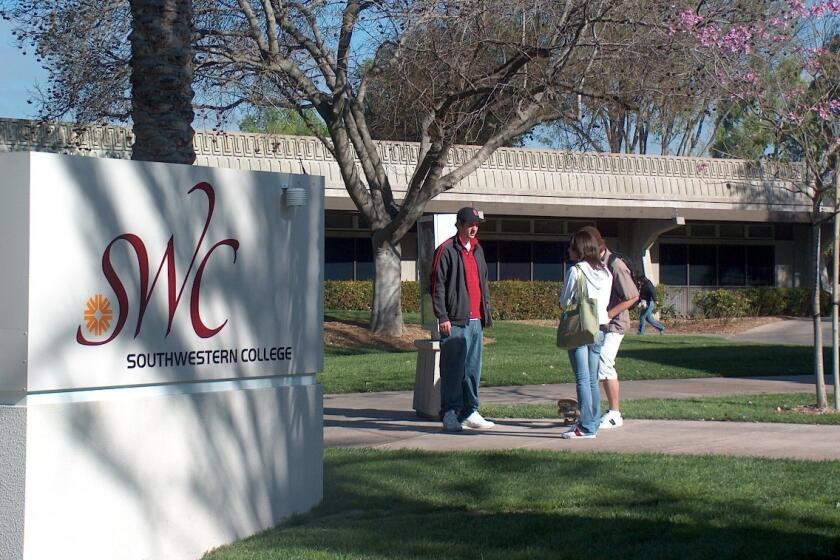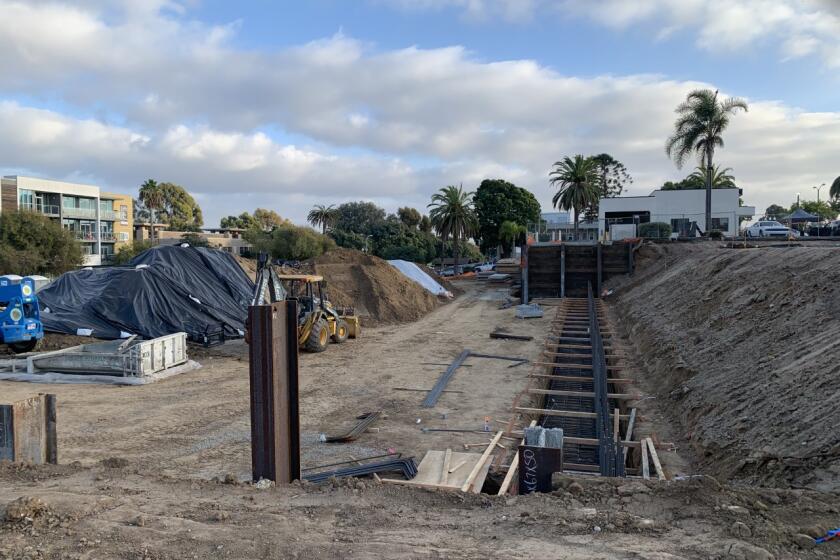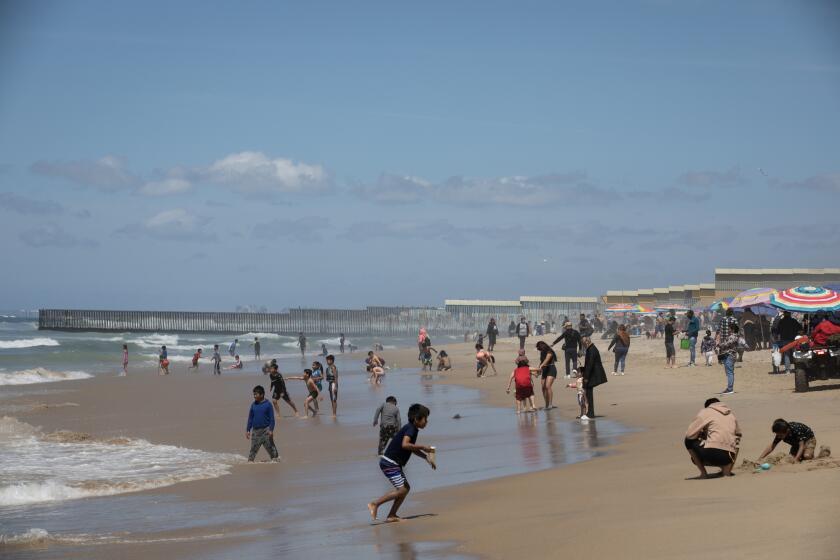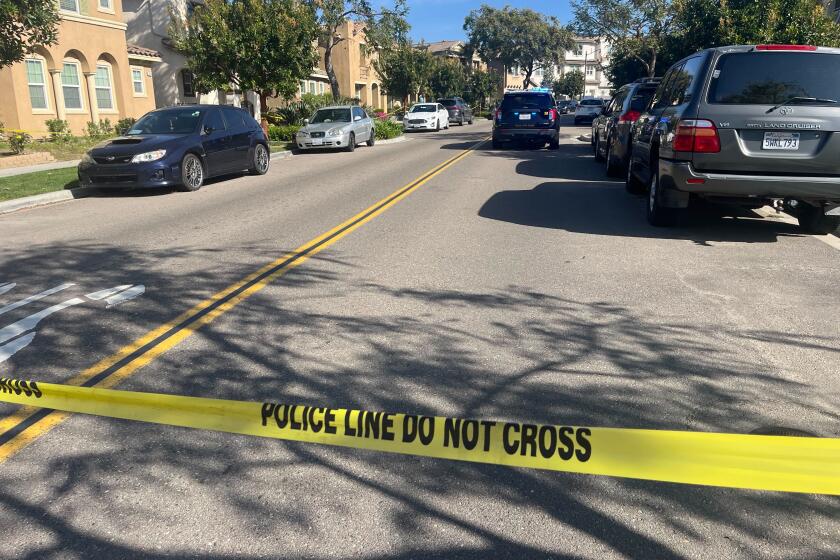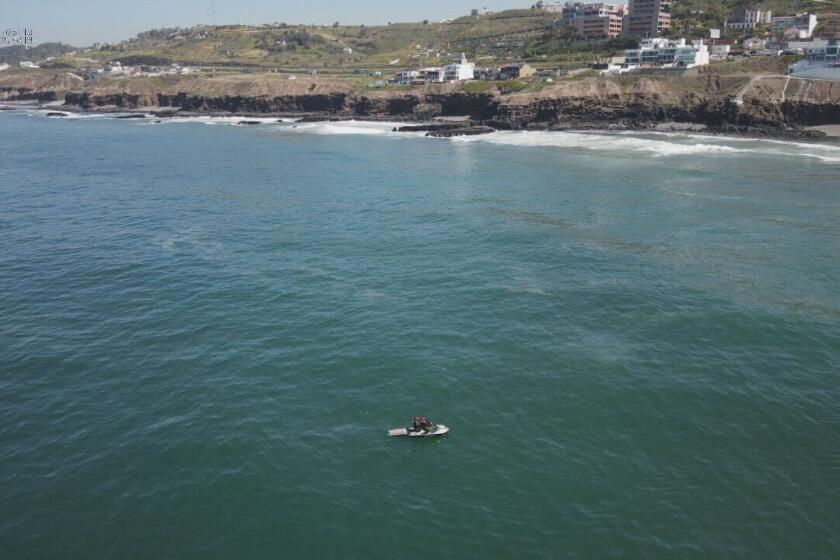Trump announces partial US-Mexico border shutdown to combat coronavirus

TIJUANA — President Donald Trump on Friday announced historic travel restrictions along the U.S.-Mexico border to slow the spread of the deadly coronavirus pandemic.
The U.S.-Mexico border will be closed to nonessential travel starting Saturday
The U.S. and Mexico have agreed to restrict all nonessential travel across their shared border in an effort to slow the spread of the coronavirus, President Trump said Friday.
Officials on both sides of the border stressed that the travel restrictions, which go into effect Saturday, would not impede lawful trade and commerce — everything from food and fuel to healthcare and medicines. Additionally, people who cross the border for work, medical appointments or to pursue education would not be impacted as long as they have the proper authorization.
“Both our countries know the importance of working together to limit the spread of the virus and to ensure the commerce that supports both our economies keeps flowing,” U.S. Secretary of State Michael Pompeo told reporters at a White House briefing.
The restrictions will last at least 30 days, according to a joint statement by the U.S. and Mexico.
Commercial goods arriving via rail and truck are exempt, as are U.S. citizens, lawful permanent residents and people with legal work permits.
“Everything that has to do with people who work in the United States who have the authorization every day to move from one place to another will not be affected either,” said Mexico’s Foreign Secretary Mareclo Ebrard.
Every day, more than $1.6 billion in goods and services flow across the border, according to the U.S. Chamber of Commerce. So, too, do roughly half a million legal workers, students, shoppers and tourists, who cross with visas.
The announcement spurred a collective sense of anxiety and uncertainty as residents who live along the southern border begin to grapple with a new reality.
In San Ysidro, home of the country’s busiest border crossing where nearly 120,000 people cross each day, the port of entry on the American side was relatively empty.
“Everything just feels so strange,” said Martin Jesus Casanova as he crossed from Mexico and headed to work at a San Diego auto body shop.
San Diego resident Tony Johnson decided to cut his Ensenada vacation short after hearing the announcement from the White House.
“I heard the news this morning as I was having coffee and thought, ‘Oh shoot, I’m probably going to be stuck here,’” he said while standing in line to enter the United States.
In El Paso, Texas, confusion ran high as cross-border commuters were caught off guard by the announcement.
“They’re going to close it?” asked Lizbeth Arellano, tearing up after crossing from Juarez. “I’m worried, my mom is over there.”
Arellano, 19, works in an El Paso clothing store and couldn’t imagine being unable to cross the border.
Others in Juarez wondered what type of visas they’d need to get across. A used car dealer who is on a temporary business visa, a B-1, didn’t know if that would allow him to go on an upcoming business trip to Denver.
“Nothing is clear,” said the man who would only identify himself as Jesus.
Answers to questions about how the travel restrictions would be implemented — such as whether cross-border travelers would need documentation from doctors or employers, or which specific visas would still be valid — were not readily available Friday afternoon.
It was also unclear how strict the scrutiny would be starting Saturday, including whether SENTRI lanes would remain open or if increased inspections would cause massive waits.
A Customs and Border Protection spokeswoman could not answer many questions regarding how specifically the new policy would work. Instead, she wrote a statement saying the government is coordinating with Mexico and Canada and the governments are “finalizing an agreement.”
In Matamoros, Maria Gallegos feared that the restrictions would prevent her from visiting her mother in Brownsville, Texas, a trip she makes twice a month.
Construction worker Juan Lopez said he’s the only one in his family who can cross. His wife and children are staying home and depend on him to pay the bills.
“I’m afraid to go out because I don’t want to get sick. But we have to work to eat,” he said. “How are we going to support ourselves?”
Experts predict the restrictions — coupled with California’s new stay-at-home order — could have a drastic impact on the cross-border economy, where many businesses on the U.S. side rely on Mexican consumers.
At the San Ysidro border crossing, cab drivers were already feeling the sting.
Friday mornings are usually a good time to work. But the drivers stood idly by as few people crossed the border and the nearby outlet malls were shuttered.
Juan Antonio tried to remain optimistic as he stared toward the border.
“We don’t know what will happen,” he said. “All of a sudden we could get a big rush of people. One long trip could change your entire day.”
Another driver, Miguel Lopez, said he hadn’t seen the border like this since the terrorist attacks of 9/11. Back then, business was so bad that the drivers managed to convince the cab company’s owners to cut their car payments in half.
“It was like this when the Twin Towers fell,” he said. “And we survived that.”
Following the terrorist attacks, the U.S. government imposed a “status one security alert” along the border, which meant that instead of waving cars through border checkpoints, officials spent more time thoroughly checking vehicles and their passengers.
News reports at the time described the enhanced security measures as “just short of stopping the human flow entirely.”
The slowdown meant that a border crossing that once took minutes to complete all of a sudden took hours. Both sides of the border felt the economic impact as Baja California’s tourist destinations saw cancellations and San Diego businesses that rely on Mexican consumers experienced a sharp drop in sales.
San Diego’s Mayor Kevin Faulconer said the new travel restrictions were necessary to ensure public safety.
“In San Diego, residents and businesses alike depend on a fully-functioning border, but right now we must put the health and safety of all people first,” he said in a statement.
In Tijuana, medical tourism has already been affected.
Francisco Carrillo, the head of the medical center SIMSA, said that on any given day the facility receives around 2,000 patients from Southern California, but in the last week, not even 200 have shown up.
Along the border, some binational commuters thought the restrictions were overblown.
The U.S. and Mexico have taken drastically different approaches to dealing with the coronavirus outbreak. For example, none of the stay-in-place orders, business closures or social distancing guidelines seen in California have made their way south of the border.
Minutes after Friday’s announcement, Tijuana’s private medical sector opened a third health screening station a few steps away from the San Ysidro border crossing to identify potential southbound carriers of the virus.
However, shops and restaurants remain open and the city hums as usual.
“Things in Tijuana are much more upbeat,” said Gloria Barrajas, 70, a U.S. citizen who’d just returned from Mexico. “Everything here is empty. It looks sad.”
Barrajas went to Tijuana early Friday to have some breakfast and do some shopping. It’s easy to find things like toilet paper in stores south of the border, she added.
“The way I see it, it’s just like the common cold,” William Jewell, who lives in Tijuana but works in San Diego, said of COVID-19. “I have Nyquil, it will do the job.”
Jewell works the graveyard shift at a gas station. He isn’t worried about getting his hours cut back because it’s not a very popular shift.
Mexico has relatively few confirmed coronavirus cases, at least 164 confirmed cases, compared with the United States’ more than 19,000, according to Johns Hopkins University data as of Friday night.
There are at least three confirmed cases in Baja California — two women in Mexicali who had traveled to Washington state and a 72-year-old man in Tijuana with a history of U.S. travel, officials said.
Because there has been an almost standing threat of a border shutdown during Trump’s entire presidency, experts have been calculating the potential catastrophic economic fallout of a full border closure with Mexico for the past several years.
White House advisers, border city leaders and U.S. economists have warned in the past that such a move would interrupt supply chains and boost U.S. consumer prices on everything from TV’s to avocados to autos.
But with trade allowed to flow unhindered, the impact would be somewhat minimized.
Still, the local business community fears an enormous fallout.
“It’s going to affect everybody, even people who don’t think that the bi-national region would affect them,” said Gustavo de la Fuente, executive director of the San Diego-Tijuana Smart Border Coalition. “It’s just the fact that you’ve got fewer tourists, fewer people coming across the border. Those people spend money on the U.S. side, whether it’s commerce or hotels or restaurants. So immediately, you have an effect.”
U.S. officials are also enacting emergency measures that allow U.S. Border Patrol agents to quickly process and turn back migrants who cross both the southern and northern borders illegally, to minimize the number of detainees in U.S. custody.
Trump on Friday said the measure will “protect the health of all three nations” in North America, and also “reduce the incentive for mass global migration that would deplete health resources needed for our people.”
But Mexico’s Ebrard said Friday that Mexico would not accept the return of migrants and asylum seekers from other nations besides Mexico and those in Central America.
U.S. authorities suggested Friday that migrants from other countries would have to be repatriated via airplanes.
Union-Tribune staff writers Rob Nikolewski and Alexandra Mendoza; special correspondents Gabriela Minjares, Connie Martinez and Edyra Espriella; and the Los Angeles Times contributed to this report.
Get Essential San Diego, weekday mornings
Get top headlines from the Union-Tribune in your inbox weekday mornings, including top news, local, sports, business, entertainment and opinion.
You may occasionally receive promotional content from the San Diego Union-Tribune.




